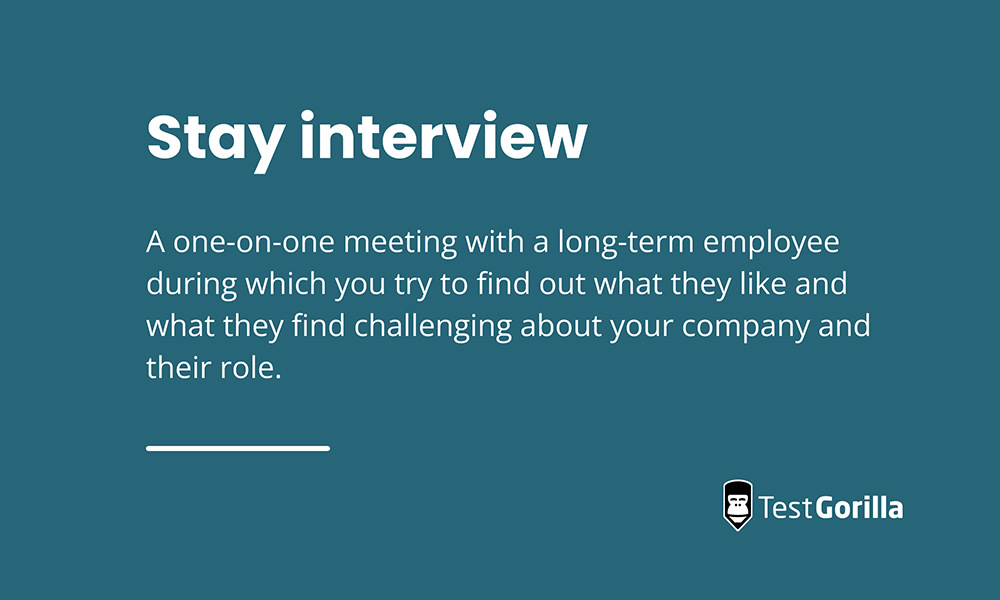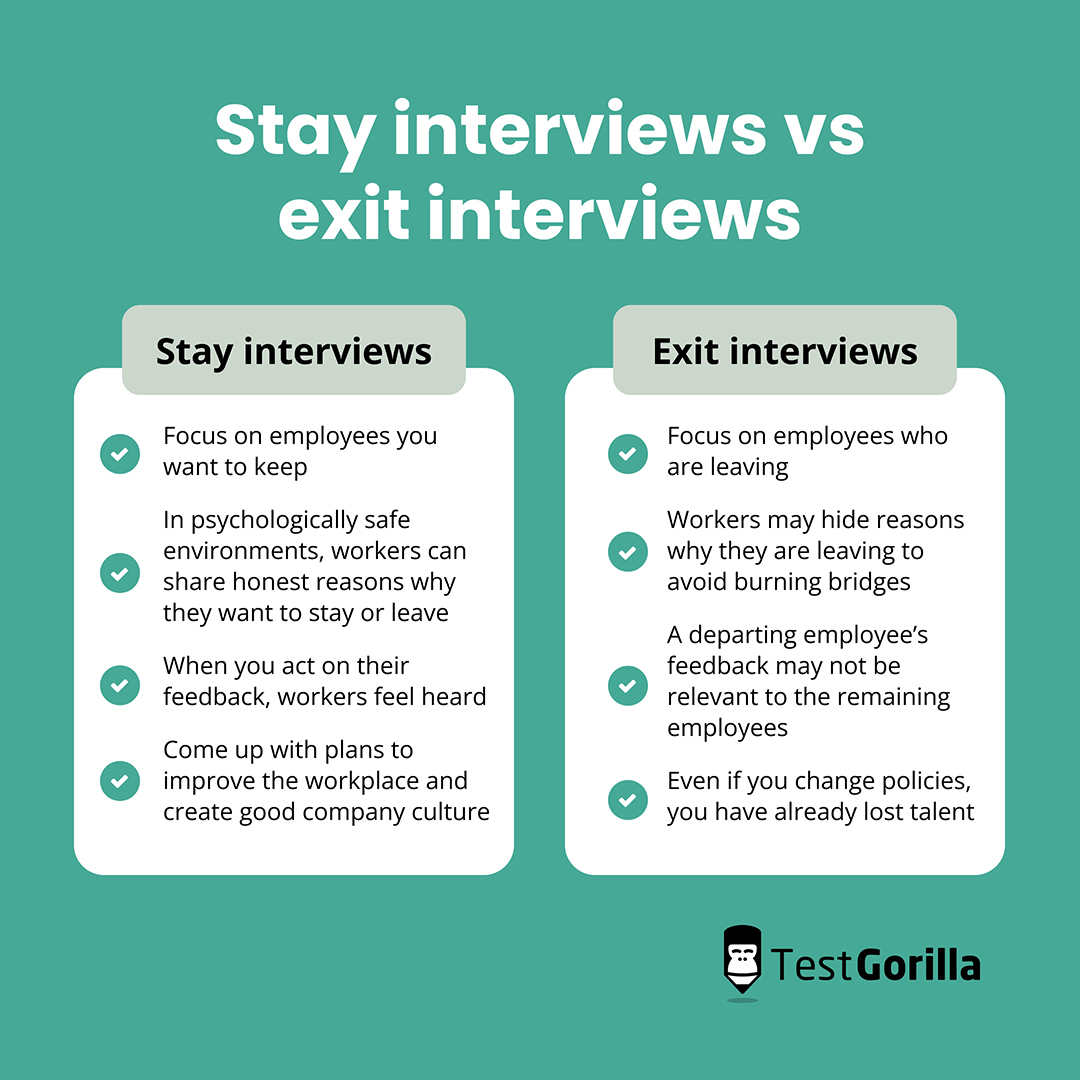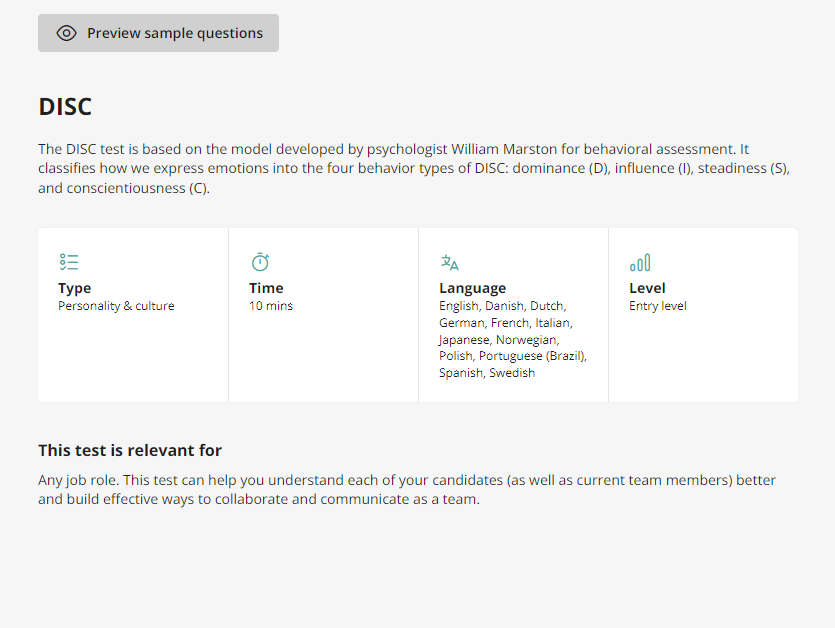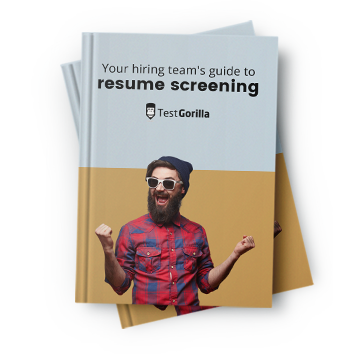Like many other HR professionals, you may use exit interviews to figure out why some employees leave your company. However, exit interviews may not give you enough information to help formulate a talent retention strategy because exiting employees have no stake in your business.
Turnover is an ongoing trend that probably isn’t slowing down anytime soon — more than 50 million workers left their jobs in 2022, leading to economists dubbing it “The Great Resignation.”[1]
One method for retaining valuable employees is through stay interviews. Asking current employees for feedback on how to improve their employee satisfaction informs your approach to reducing turnover.
The success of this trend can be indicated by its growing popularity. One study discovered that more and more organizations find stay interviews valuable, with 50% of companies using or planning to use them in the near future.[2]
When you couple stay interviews with talent assessments that test for traits like culture add, they can give you a more complete picture of your employees’ wants and needs. When acted upon wisely, this helps prevent turnover.
In this article, we dive into the benefits of stay interviews and how to conduct them. We also get you started with a list of 11 questions to ask your employees in their interviews.
Table of contents
- What is a stay interview?
- Why are employee stay interviews important?
- The benefits of stay interviews
- The 11 best stay interview questions
- 8 best practices for leveraging stay interviews to retain your best performers
- 5 examples of companies succeeding with stay interviews as a talent retention strategy
- Leverage the stay interview as a retention strategy
What is a stay interview?
A stay interview is a one-on-one meeting with a long-term employee during which you try to find out what they like and what they find challenging about your company and their role.
When regularly conducted, stay interviews give you time to identify and fix problems by acting on the feedback you receive from employees. This can prevent the need for exit interviews.
Although they’ve been a long-lasting talent retention trend, exit interviews happen when employees are on the verge of leaving, so the information you gather from them doesn’t always prevent attrition.
One possible outcome of stay interviews is to provide workers with upskilling opportunities if they feel “stuck” in their current position and ask for internal mobility but don’t have the required skill set for an immediate promotion.
Here are the main differences between the information you can gather in stay interviews vs exit interviews:
Stay interviews | Exit interviews |
Focus on employees you want to keep | Focus on employees who are leaving |
In a psychologically safe environment, workers can share honest reasons why they want to stay or leave | Workers may hide the real reasons why they are leaving to avoid burning bridges |
When you act on their feedback, workers feel heard | A departing employee’s feedback may not be relevant to the remaining employees |
You can come up with plans and policies to improve the workplace and create a good company culture | Even if you change policies, you have already lost talent |
Why are employee stay interviews important?
Stay interviews are beneficial for both employers and employees. Thanks to upward feedback from workers, employers can discover the needs of their team members.
For example, some employees may be looking for opportunities for advancement but don’t feel comfortable bringing this request up on their own.
Employers can also uncover the initial stages of burnout and other underlying issues. You can use this information to change your policies by offering employees flexible work arrangements. By helping workers feel cared for, you can better retain them and prevent turnover.
Stay interviews include discussing how happy workers are with your business practices so they can help you improve, giving insight into your employer branding.
This way, individual employees also feel your organization wants to hear about their challenges and better understand them. They are more likely to feel valued when you consider their opinions and act to improve their work environment.
The benefits of stay interviews
Besides being important for employer and employee communication, effective stay interviews have tangible benefits for organizations.
These benefits range from higher retention to reduced recruitment costs, and they can help you create a great work environment and an inclusive workplace.
Benefit | How it helps |
A better employee retention rate | - Fifty-two percent of workers who left their jobs said their manager or company could have done something to prevent their departure. - According to industry leaders, since stay interviews have become a bigger trend and companies take active measures to prevent employees from leaving, the employee retention rate has seen a 10% increase. |
Higher employee engagement | - More than 85% of employees feel managers don’t hear their coworkers fairly or equally. On the other hand, engaged employees are three times more likely to say they feel heard at their workplace.[3] - With stay interviews, you can boost engagement by making employees feel heard and valued. |
Stronger financial performance | - Stay interviews also contribute to stronger financial performance. For example, 88% of companies financially outperform others in their industry when their employees feel heard at work.[3] |
Improved productivity | - When workers can talk about their issues and know you listen, they’re better at completing their tasks. - Almost 75% of employees report being more effective at their jobs when they feel heard.[3] |
Better team morale | - Stay interviews help you build a good environment for happy workers, which fosters positive personal relationships and higher morale. - High-morale employees who feel their voices are heard are 4.6 times more likely to want to do their best work. |
Reduced long-term recruitment costs | - Studies have shown that the total cost of hiring a new employee can be three to four times the position’s yearly salary.[4] - Because stay interviews reduce turnover and increase retention, they reduce the need for new hires and their accompanying extra costs. |
The 11 best stay interview questions
Let’s look at the 11 best stay interview questions, and the sequence you should ask them to get the best feedback from your employee during your regular check-ins.
1. What do you look forward to at work?
This question helps you figure out what your employees love about their jobs. You can discover what engages and motivates them about their job and your company, whether it be the work environment you’ve cultivated or the work itself they pride themselves in.
2. What do you dislike about work?
Here, you can discover an employee’s biggest challenges. When you resolve these challenges, they can achieve their potential and become more productive.
3. How could your work-life balance be improved?
With this question, you can discover whether employees feel overworked and may be on their way to burnout. Alternatively, you may also find that some workers are interested in taking on more work.
4. Why have you stayed here?
This question shows you what works well in your organization and their current role. Play to these strengths to elevate the employee experience for everyone who works for you.
5. What do you think about our company’s recognition strategy?
Here, you can check whether your employee recognition program and perks are adequate or whether employees don’t feel recognized for what they do.
6. Have you experienced any anxiety or frustration in the past months? Was it alleviated eventually?
This question lets you assess if you have adequate policies in place to reduce stress and anxiety or if you need to provide more support to your workers.
7. What do you think about the learning and growth opportunities here?
If your employees feel they’re stagnating, they can become demotivated and look for greener pastures. This question lets you discover their thoughts about their career paths and upskilling opportunities.
8. What are you learning here and what would you like to learn?
Here, you can see whether your professional development plans match your employees’ interests and expectations. If they don’t, you can make adjustments to turn your workplace into a lifelong learning space.
9. What can I do to improve your experience?
Here, you can hear about concrete actions to increase your employees satisfaction with their jobs. It’s important to listen attentively and act on their suggestions.
10. What does your dream job look like?
With this question, you can find out about employees’ skills and goals you may not know about. It can help you make a career development plan for employees to align their careers with their ideals.
11. Have you ever considered leaving us? If so, what prompted it?
Ask this question to find out what motivators your employees may be lacking. It can be a higher paycheck, better employee work-life balance, or remote work options. Try to devise a plan for the employee that incorporates these findings.
8 best practices for leveraging stay interviews to retain your best performers
Asking the right questions is not the only way to use stay interviews to retain your best workers.
Below, we discuss eight best practices to add to your stay interview toolkit so you can see the positive results of this retention strategy.
8 best stay interview practices: Summary
Best practice | What it does |
1. Use talent assessments to help managers prepare for stay interviews | Helps managers prepare interview questions in advance to tailor them for each employee |
2. Conduct stay interviews regularly in a private, comfortable location | Enables employees to feel comfortable giving you regular feedback |
3. Use an easily personalized template | Lets you come up with a checklist for your meeting with foundational and personalized questions for each worker |
4. Clarify the purpose of the stay interview | Informs your workers that you’re proactively trying to identify what contributes to their job satisfaction to retain them |
5. Focus on listening rather than talking | Enables you to focus on the feedback, make notes, and ask open-ended questions |
6. Use stay interviews with your best workers | Lets you use your best workers’ feedback to improve the employee experience of your entire workforce |
7. Respond to feedback proactively | Makes employees feel heard and valued, improving their job satisfaction |
8. Build a culture of psychological safety | Reduces turnover, boosts team performance, and improves your corporate reputation |
1. Use talent assessments to help managers prepare for stay interviews
Talent assessments are great tools during the recruitment stage, enabling you to find the candidates with the best hard and soft skills for open roles and create diversity in the workplace.
They are equally useful when managers are preparing for stay interviews.
Preparing interview questions in advance lets you tailor them to each individual’s position and personality. One way to understand the unique behaviors of your employees is by sending out personality and culture assessments, such as the DISC personality test.
Test results can help you prioritize the right questions. For instance, a question like, “Are you getting enough support in your role?” would be relevant for someone with a DISC High Steady style who relies heavily on others’ opinions.
Once you understand your employee’s unique personality traits, you can get insights into what motivates them and the environment they need to thrive.
These results can inform your employee development plan and the employee benefits and perks you offer for each role.
2. Conduct stay interviews regularly in a private, comfortable location
When you make a hire, and the employee settles into their new role, you can start conducting stay interviews. These interviews should continue for the remainder of their employee life cycle.
Stay interviews are one-on-one meetings that should take place in a private, comfortable, and distraction-free location.
The choice of location boils down to a setting where you and the employee feel comfortable having an honest conversation.
Ideally, it’s away from their workspace and provides privacy to encourage them to speak their mind.
You can have stay interviews at regular intervals. However, ensure you don’t schedule them when your employee is busy, has immediate deadlines, or is otherwise pressed for time.
Ideally, each employee should have one stay interview per year.[5]
However, depending on your industry and retention needs, you can also consider different arrangements:
Have “pulse” stay interviews with your best workers throughout the year to address their concerns and needs as they occur
Schedule stay interviews at each step of the worker’s life cycle after onboarding
3. Use an easily personalized template
Once you pick a location for your stay interview, you should consider how to organize your meeting.
You can’t use the same approach for each employee, but you can make it easier when you build a stay interview template. A template can also include a checklist that helps guide your conversation.
Some foundational questions apply to all your employees, but others can be personalized depending on the worker you invite to the interview.
Foundational questions include finding out whether employees are happy with their jobs and find them fulfilling and whether learning opportunities fit their needs.
Personalized questions can touch on things workers would change in their personal environment and the type of resources they need.
To effectively choose personalized questions, you can use your understanding of the employee’s hard and soft skills based on their talent assessment results.
For example, if an employee scored highly as a culture add, you can ask whether they feel rewarded for supporting your company’s values.
4. Clarify the purpose of the stay interview
Clarifying the purpose of stay interviews means communicating to your employees the need to be honest in their assessment of your company and their job.
Explain that you plan to use the results of the stay interview to shape policy and make positive changes to empower them and make their jobs easier.
Tell your workers that you are proactively trying to identify what contributes to their job satisfaction and loyalty to the company because you want to retain them.
More importantly, ensure that your employees don’t think that stay interviews are part of their performance review.
Conducting stay interviews and performance reviews simultaneously is problematic. Here are the main reasons why:
Unfocused attention. Having stay interviews and performance reviews at the same time muddies the waters between objective, metric-based performance assessments and understanding non-objective factors like an employee’s engagement level or job satisfaction.
Comfort level. Many employees feel stressed about performance reviews. Their comfort levels increase during a stay interview because they don’t worry about being assessed. If they think you’re evaluating them during the stay interview, they may close up and not provide you with honest feedback.
Bias. Because stay interviews explore employees’ feelings and concerns, they can become subjective. Subjectivity breeds bias, which doesn’t belong in performance reviews. These should stay objective and use measurable criteria.[6]
Schedule performance reviews and stay interviews at least three months apart each year to clarify the separation between them.
5. Focus on listening rather than talking
Although interviews usually involve talking on both sides, you must focus on listening in a stay interview.
After all, when you conduct stay interviews, you want to find out as much as possible about your employee’s situation, opinions, and challenges.
Some research recommends that stay interviews be 80% listening and 20% asking questions, digging for more information, and clarifying points.
Doing so ensures that your workers can dive deeply into what is working and not working for them.
While you listen, you should also take detailed notes about the key points of the employee’s feedback and their emotional trigger points to make finding solutions easier after the interview.
Finally, when you do talk, ask open-ended questions, which enable a more engaging conversation with your worker. These questions can prolong your meeting because they foster discussion but encourage workers to expand on what you need to know.
Under no circumstances should you get defensive about the feedback the employee provides. You would risk invalidating their concerns and losing valuable information for you to act upon. It may even push them closer to leaving.
6. Use stay interviews with your best workers
Depending on the size of your company, you may be tempted to use stay interviews with all your employees.
However, that’s not the right approach – at least not initially.
Some turnover occurs regardless of your best efforts to retain workers, so you should use stay interviews with your best employees whose departure would leave a skill gap in your company.
These employees aren’t looking for opportunities outside the company, so they’re in the perfect position to tell you what’s working and what needs to change.
This approach can help you retain your top performers, but it can also help you improve the employee experience of your entire workforce.
Examples include offering more career growth opportunities or hiring more people to give your entire workforce more work-life balance.
7. Respond to feedback proactively
So far, we looked at the best practices for conducting stay interviews. However, it’s what you do after receiving employee feedback that’s paramount for this retention strategy’s success.
Try to act on feedback as soon as possible. The best way to build trust is to listen to your employees’ concerns and take action on them.
Your employees show courage by offering honest feedback about what isn’t working rather than merely agreeing on what is.
Failing to take action erodes your credibility and their trust, showing them that their opinions and concerns aren’t important enough to create positive change.
To address feedback from stay interviews proactively:
Communicate the changes you plan immediately, especially if they are easy fixes
Make a plan to keep your employees updated on changes stemming from stay interviews online and in meetings
Explain why you can’t address all feedback and show them why you can’t act on a particular request
Where possible, provide alternatives to show your employees you aren’t ignoring them
For example, if your remote employee asks you to help with work-life balance by covering cleaning services for their home, you may not have the resources to give them that exact perk. However, you can offer them paid days off instead to help them juggle responsibilities.[7]
8. Build a culture of psychological safety
Psychological safety refers to workers feeling free to discuss their concerns, make suggestions and mistakes, and ask questions without fearing retaliation or ridicule.
If you want to use stay interviews to reduce your employee turnover rate, you must ensure your employees feel safe enough to share their honest opinions.
Your workplace culture should focus on employee wellness and psychological safety, or your employees are unlikely to open up. Worse, they may lie outright, rendering the whole stay interview process useless.
To foster an inclusive culture that encourages honest and open feedback from employees:
Show empathy
Make transparent decisions
Promote respect and avoid playing the blame game
Show zero tolerance for negativity
Offer different lines of communication to suit all your employees’ needs
Ensure managers hold themselves accountable
Besides reducing turnover and maximizing the effectiveness of your stay interviews, a psychologically safe culture boosts team performance and can improve your corporate reputation.
5 examples of companies succeeding with stay interviews as a talent retention strategy
Now that you’re equipped with the stay interview best practices to leverage stay interviews, let’s see how other companies have been successful in using them as a talent retention strategy.
5 examples of companies succeeding with stay interviews: Summary table
Let’s take a quick look at five companies that have had success using stay interviews.
The company | How it uses stay interviews |
1. Sensei Labs | Holds one-on-one meetings and uses feedback to decide on work flexibility and remote work policies |
2. Security Compass | Uses “employee engagement interviews” to prevent the departure of high-performing employees |
3. ABC Technologies | Holds monthly interviews and feedback to improve the employee experience |
4. PM Hotel Group | Used interviews to develop a database for bench strength and gain a clear understanding of the company’s growth plan |
5. TestGorilla | Uses stay interviews in conjunction with engagement surveys to retain employees |
Sensei Labs
Sensei Labs, an organization transformation platform, uses stay interviews to better understand what workers want regarding flexibility in the workplace.
The company also uses a quarterly happiness survey that asks employees whether they’re likely to recommend it as a place of employment.
These stay interviews have informed Sensei Lab’s policy on returning to the office.
In response to the staff speaking out against a return to the office, the company let them continue working remotely.
Feedback from the workers has also convinced the company to pilot a four-day work week that “has changed the staff’s life,” according to Tara Vanderloo, the company’s chief experience officer.[7]
Security Compass
Security Compass, a cybersecurity firm, uses “engagement interviews” to prevent the departure of its top performers.
The company uses the conversation to measure engagement, which it uses as a metric to indicate whether its top employees intend to stick around.
Michelle Brooks, the firm’s chief people and culture officer, has gotten valuable insights from the interviews, including that some of her top employees do not necessarily want promotions. Instead, they want more opportunities to learn and develop.[7]
Although Security Compass doesn’t mind losing some employees to voluntary turnover, Brooks says they have succeeded in using stay interviews to retain top talent.
ABC Technologies
ABC Technologies, an automotive firm, started using stay interviews after discovering that exit surveys and interviews weren’t working for their needs and high employee attrition rate.
The company’s HR professionals hold monthly interviews to gain a clearer picture of what employees like about their employer and what isn’t working.
They have also been keen to take action on the feedback received.
When employees felt underpaid relative to the competition, ABC Technologies increased their pay by four percent annually.[8]
Likewise, when floor employees explained that they missed in-person interactions with managers, the latter made a point to visit them regularly.
The company’s efforts have resulted in a moderate decrease in turnover so far.
PM Hotel Group
PM Hotel Group, a hospitality chain, used an interview process to develop a database for bench strength and gain a clear understanding of the company’s growth plan.[9
For a year, the company worked with its senior vice president of sales and marketing to discuss the directors of sales’ personal journeys in sales and their growth goals. In addition, they also received employee coaching on demand.
The program’s results included changes to work-life balance, schedule flexibility, employee training programs, and benefits and salary packages.
The chain also used this interview process to express gratitude to the various teams and recognize their achievements.
TestGorilla
Nadia Vatalidis, the head of people and culture here at TestGorilla, finds stay interviews useful for a company with a small people team.
We hold stay interviews for cohorts to meet with employees from various teams rather than with each employee.
The cohorts include, in no particular order:
The top 10-15% of highest scorers in the latest performance review cycle
Teams going through changes
Workers picked by the leadership team each quarter
We also send candidate experience, onboarding satisfaction, and annual engagement surveys for feedback to change policies and improve our employees’ experiences.
As an asynchronous company, TestGorilla holds weekly one-on-one meetings with everyone on each team to find immediate needs to address directly.
Leverage the stay interview as a retention strategy
Stay interviews are a great way to improve retention by using direct feedback from your workers to improve your work environment and culture.
When you conduct them regularly, involve your best workers, actively listen, and respond to feedback proactively, you invite improved retention, employee engagement, productivity, and team morale.
To learn more about improving retention, read about ways to deal with employee flight risk.
Moreover, if you’re ready to start your first stay interview, go through our personality and culture tests to create the best assessment that will help you prepare your questions in advance.
Sources
1. Iacurci, Greg. (February 1, 2023). “2022 was the ‘real year of the Great Resignation,’ says economist”. CNBC. Retrieved November 6, 2023. https://www.cnbc.com/2023/02/01/why-2022-was-the-real-year-of-the-great-resignation.html
2. “Please don’t go! Companies Conduct Stay Interviews to Keep Key People”. (April 28, 2016). Challenger, Gray, & Christmas, Inc. Retrieved November 6, 2023. https://www.challengergray.com/blog/please-dont-go-companies-conduct-stay-interviews-keep-key-people/
3. Marcroft, Darlene. (June 22, 2021). “A Silenced Workforce: Four in Five Employees Feel Colleagues Aren’t Heard Equally, Says Research from The Workforce Institute at UKG”. UKG. Retrieved November 7, 2023. https://www.ukg.com/about-us/newsroom/silenced-workforce-four-five-employees-feel-colleagues-arent-heard-equally-says
4. Navarra, Katie. (April 11, 2022). “The Real Cost of Recruitment”.SHRM. Retrieved November 7, 2023. https://www.shrm.org/resourcesandtools/hr-topics/talent-acquisition/pages/the-real-costs-of-recruitment.aspx
5. Payne, Christine. (September 14, 2023). “What Is a Stay Interview? Best Practices Plus 15 Questions to Ask”. Access. Retrieved on November 8, 2023. https://access.intix.org/Full-Article/what-is-a-stay-interview-best-practices-plus-15-questions-to-ask-1
6. Verlinden, Neelie. “Your In-Depth 2023 Guide to Stay Interviews (Plus Best Questions to Ask)”. Academy to Innovate HR. Retrieved November 9, 2023. https://www.aihr.com/blog/stay-interviews/
7. Deschamps, Tara. (May 29, 2023). “More Canadian companies adopt ‘stay interviews’ amid push to retain staff”. Global News. Retrieved November 9, 2023. https://globalnews.ca/news/9729568/canada-stay-interviews-employees/
8. Rolfe, Kelsey. (November 1, 2023). “Goodbye exit interviews: Stay interviews the latest tool employers are using to ensure happy workers”. Financial Post. Retrieved November 9, 2023. https://financialpost.com/fp-work/stay-interviews-employers-tool-happy-workers
9. Casiero, Lovell. (September 28, 2022). “How stay interviews can improve employee retention”. HSMAI Asia Pacific. Retrieved November 9, 2023 https://hsmaiasia.org/2022/09/28/how-stay-interviews-can-improve-employee-retention/
Related posts
Hire the best candidates with TestGorilla.
Create pre-employment assessments in minutes to screen candidates, save time, and hire the best talent.
Latest posts
The best advice in pre-employment testing, in your inbox.
No spam. Unsubscribe at any time.

Hire the best. No bias. No stress.
Our screening tests identify the best candidates and make your hiring decisions faster, easier, and bias-free.
Free resources
Anti-cheating checklist
This checklist covers key features you should look for when choosing a skills testing platform
Onboarding checklist
This resource will help you develop an onboarding checklist for new hires.
How to find candidates with strong attention to detail
How to assess your candidates' attention to detail.
How to get HR certified
Learn how to get human resources certified through HRCI or SHRM.
Improve quality of hire
Learn how you can improve the level of talent at your company.
Case study: How CapitalT reduces hiring bias
Learn how CapitalT reduced hiring bias with online skills assessments.
Resume screening guide
Learn how to make the resume process more efficient and more effective.
Important recruitment metrics
Improve your hiring strategy with these 7 critical recruitment metrics.
Case study: How Sukhi reduces shortlisting time
Learn how Sukhi decreased time spent reviewing resumes by 83%!
12 pre-employment testing hacks
Hire more efficiently with these hacks that 99% of recruiters aren't using.
The benefits of diversity
Make a business case for diversity and inclusion initiatives with this data.


























